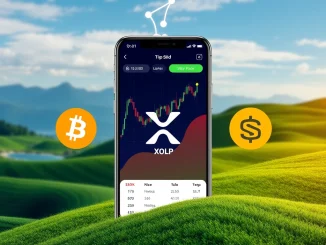
The cryptocurrency world is buzzing, and for good reason. For the first time since June 2024, Ethereum spot volume has dramatically eclipsed Bitcoin’s, marking a significant turning point in the digital asset landscape. This isn’t just a fleeting moment; it’s a powerful signal that investor attention is rapidly shifting, driven by a confluence of exciting developments.
Why Ethereum Spot Volume is Surpassing Bitcoin’s
Last week, Ethereum’s spot trading volume soared to an impressive $25.7 billion, leaving Bitcoin’s $24.4 billion in its wake. This monumental shift pushed the ETH/BTC spot volume ratio above 1, a metric closely watched by analysts. What’s behind this sudden surge? It’s a combination of factors indicating a growing rotation of capital towards Ethereum and the broader altcoin market. Investors are keenly eyeing Ethereum’s potential, moving beyond Bitcoin’s recent consolidation phase post-halving. This rebalancing suggests a search for higher growth opportunities, with Ethereum emerging as the undeniable focal point.
Spot Ethereum ETF Anticipation Fuels Growth
A major catalyst for this renewed interest is the palpable excitement surrounding potential U.S. Spot Ethereum ETF approvals. Following the groundbreaking success of Bitcoin ETFs earlier in 2024, the crypto community is anticipating a similar institutional influx for Ethereum. Such an approval would not only legitimize Ethereum further in the eyes of traditional finance but also unlock significant institutional access and liquidity. Imagine the floodgates opening, mirroring the trajectory Bitcoin experienced – enhanced accessibility often leads to increased demand and price appreciation. This prospect alone is enough to send ripples of optimism throughout the market.
The Significance of the ETH BTC Ratio Above 1
The ETH BTC ratio crossing the 1 threshold is more than just a statistical anomaly; it’s a historically significant indicator. When Ethereum’s spot volume outpaces Bitcoin’s, it often signals a fundamental shift in investor sentiment. Historically, this trend has preceded periods of robust altcoin outperformance. It suggests that market participants are becoming more comfortable diversifying beyond Bitcoin, seeking opportunities in the broader crypto ecosystem. This ratio also highlights Ethereum’s growing maturity as a tradable asset, offering institutional investors a more liquid and diverse portfolio option. While Bitcoin remains the king, Ethereum is increasingly asserting its role as a formidable contender and a bellwether for the altcoin market.
Is an Altcoin Season on the Horizon?
The implications of Ethereum’s volume surge extend far beyond ETH itself. A rising ETH/BTC ratio frequently heralds the beginning of an “altcoin season,” a period where altcoins collectively outperform Bitcoin. As the largest altcoin by market capitalization, Ethereum’s strength acts as a powerful catalyst, injecting momentum across its vast ecosystem. This benefits a wide array of projects, particularly those deeply integrated with its network. Think Layer 2 solutions like Arbitrum and Optimism, which are already seeing increased adoption as Ethereum’s scalability improves, or the myriad of DeFi protocols built on its foundation. This could be the prelude to a broader market rally for innovative decentralized applications.
Ethereum Network Upgrades and Ecosystem Expansion
Beyond speculative interest, fundamental advancements are bolstering Ethereum’s appeal. Recent technical milestones, such as the Dencun and the eagerly awaited Pectra upgrades, are continuously enhancing the network’s scalability and efficiency. These Ethereum Network Upgrades are crucial for reducing transaction costs and improving overall user experience, making the network more attractive for both developers building decentralized applications and users interacting with them. This continuous improvement fosters a vibrant and expanding ecosystem, attracting more projects, users, and ultimately, more capital. The combination of technological prowess and market anticipation paints a compelling picture for Ethereum’s future.
Navigating the Shift: Opportunities and Risks
For investors, this shift presents both exciting opportunities and inherent risks. Ethereum’s burgeoning ecosystem offers the potential for higher returns during bullish cycles, especially as its network enhancements unlock new use cases and drive adoption. However, it’s crucial to remember that altcoins, including Ethereum, are inherently more volatile than Bitcoin. Regulatory uncertainties, particularly concerning the evolving compliance requirements for spot ETFs, could introduce market turbulence. Therefore, a balanced approach is key. Diversifying portfolios to include Ethereum and its surrounding ecosystem, while diligently employing risk management strategies, will be critical for capitalizing on this evolving market dynamic.
Conclusion: Ethereum’s Defining Moment
Ethereum’s recent achievement of surpassing Bitcoin in spot trading volume is more than just a fleeting statistic; it’s a profound indicator of its evolving role in the crypto market. With a powerful trifecta of technical upgrades, impending regulatory developments like the Spot Ethereum ETF, and robust ecosystem growth, Ethereum is undeniably redefining investor expectations. While Bitcoin will always remain a foundational asset, Ethereum’s proven ability to attract significant liquidity and institutional capital suggests a sustained shift in market dynamics. This development could very well signal a broader trend where decentralized innovation gains even greater traction, reshaping how astute investors approach digital assets in the years to come. The future of crypto looks increasingly multi-faceted, with Ethereum leading the charge into new frontiers.
Frequently Asked Questions (FAQs)
Q1: What does it mean for Ethereum’s spot volume to surpass Bitcoin’s?
A1: When Ethereum’s spot trading volume exceeds Bitcoin’s, it indicates a significant shift in investor interest and capital allocation. It suggests that more traders are actively buying and selling Ethereum, often driven by optimism around its future prospects, network upgrades, and potential new investment products like Spot Ethereum ETFs.
Q2: How does the ETH/BTC ratio relate to an “altcoin season”?
A2: The ETH/BTC ratio is a key indicator of Ethereum’s performance relative to Bitcoin. When this ratio rises, especially above 1 in terms of volume or price, it often signals a broader rotation of capital from Bitcoin into altcoins. Historically, this trend has preceded periods known as “altcoin season,” where a wide range of altcoins experience significant price appreciation.
Q3: What role do Spot Ethereum ETFs play in this volume surge?
A3: The anticipation of Spot Ethereum ETF approvals in the U.S. is a major driver. Similar to Bitcoin ETFs, these products would provide traditional financial institutions and retail investors with an easier, regulated way to gain exposure to Ethereum. This increased accessibility is expected to bring substantial new capital and liquidity into the Ethereum market, boosting demand and trading volume.
Q4: What are “Ethereum Network Upgrades” and how do they impact its value?
A4: Ethereum Network Upgrades, such as the Dencun and upcoming Pectra upgrades, are continuous improvements to the blockchain’s underlying technology. These upgrades aim to enhance scalability, reduce transaction costs (gas fees), and improve overall network efficiency. By making Ethereum faster, cheaper, and more robust, these upgrades attract more developers and users, fostering ecosystem growth and increasing the network’s intrinsic value.
Q5: Is it risky to invest in Ethereum or other altcoins during this period?
A5: While the current trends suggest exciting opportunities, investing in Ethereum and other altcoins always carries inherent risks due to their higher volatility compared to Bitcoin. Regulatory uncertainties and market fluctuations can lead to significant price swings. It’s crucial for investors to conduct thorough research, understand the risks, and implement sound risk management strategies, such as diversification, to navigate the market effectively.



